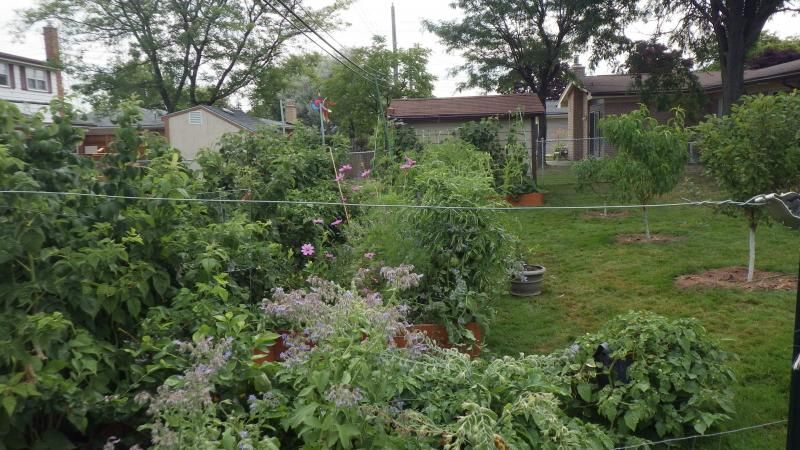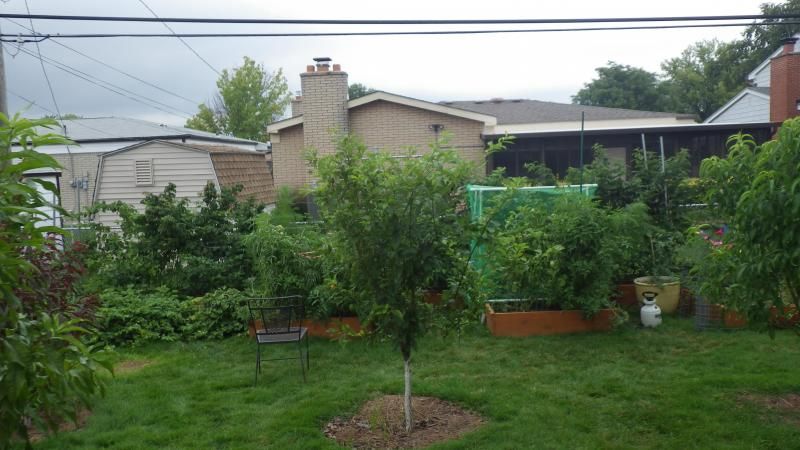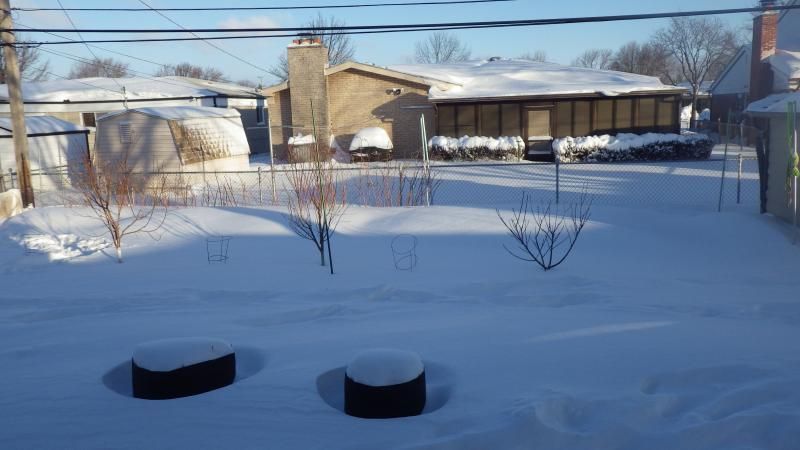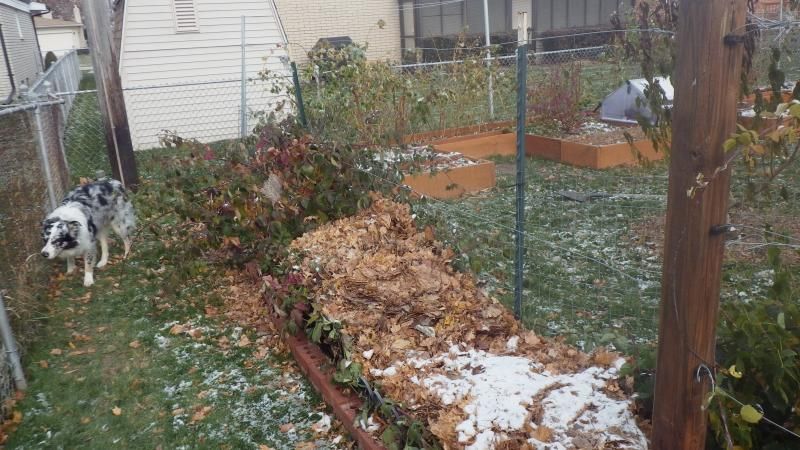

|
A garden is only as good as the ground that it's planted in. Discussion forum for the many ways to improve the soil where we plant our gardens.
|
 |
|
|
Thread Tools | Display Modes |
|
|
#1 |
|
Tomatovillian™
Join Date: Apr 2014
Location: Ontario Canada
Posts: 323
|
Hi - I'm relatively new to gardening. This will be my third summer with 4 raised beds (4 feet by 8 feet each). The soil in them is okay, I get great yields and happy plants, but I know it can be improved. Last summer, with all the soil bear it cracked and became rock hard around my plants, and there wasn't worm to be found. I know MUCH more now.
What I want to know is if my plan for this spring is a good one to help improve the soil. I put 4 inches of leaves on each bed last fall. Those will be compacted down into a thick mat when this snow ever leaves. My original plan was to add 1 bag of composted manure to each bed, as much of my homemade compost as there is to each bed, the coffee grounds I have been saving and some fresh lawn clippings and mix that and the leaves in with the top 6 inches of soil. THEN I would use woodchips as mulch this year. I think at season's end, I would add more leaves, and let them compost over the winter. What should I do in the spring? Should i just leave it as is (no till) or stir in the old mulch and add fresh stuff? Does raking or mixing the very top of the soil disturb the wonderful soil microbes? Is there anything I should be adding that I haven't? |
|
|

|
|
|
#2 | |
|
BANNED
Join Date: Jan 2012
Location: Land of the White Eagle
Posts: 341
|
Quote:
This is my opinion on tillage, and I got this idea from Plowman's folly, which I enjoy more than the Bill Mollison and the Japanese guy with the hard to pronounce name - its like this - imagine for several thousand years southern europe was richer than northern, and then the moldboard plow is created, well that is great because now you can till land that was unmanageable previously, now add new world crops like the potato and you have a combination that is guaranteed to drive population and economic growth. That being said, we mistake correlation and causation. we continue to plow every single year because we think that it is necessary, but it is not - what was necessary was plowing the first year, afterwards it runs into diminishing returns, and worse - soil erosion, and then you create a vicious cycle, but it is covered up by the fact that everything is still "working" because we are still making economic gains. So overall I use no-till but I don't expect miracles from it - I just want to prevent soil erosion and I believe I have achieved this to a large extent. On top of that I try to replace the biomass that I take out in the form of fruit, so I like to add old leftover pieces of used fruit and whatnot, I also encourage various strains of mycelium. When I started, the soil was so compact that I couldn't get a shovel more than 6 inches deep, it was horrible, but now its more lush and soft, and is responding to my quasi-permaculturish design. Now it is my garbage dump for organic materials, it rejects many seed I sow but accepts others and has grow-back from many different vegetables each year, so I barely do any work, and no weeding at all. I can't compare this to anything else quantatatively, but my kids are happy and I am always thrilled to see what new feral strain of x vegetable pops up in spring. They like to throw seeds about and see what will happen, because we don't sow beneath the earth. I do: zero weeding zero watering and zero hedging and get every year a plethora of strains that are virile enough to stand against the elements. I am the laziest gardener on earth and it pays off just plenty. and an addendum - I do NOT plant tomatoes in this garden, my tomatoes are in containers because I don't want to let the tomatoes sprawl or be cross pollinated without my knowledge - this design is for carrots, squashes, beans, asparagus, strawberries and other feral friends of mine. Last edited by snugglekitten; March 2, 2015 at 05:31 PM. |
|
|
|

|
|
|
#3 |
|
Tomatovillian™
Join Date: Apr 2014
Location: Ontario Canada
Posts: 323
|
Snugglekitten - that gardening philosophy is so contrary to everything I've ever been taught, it is fascinating to me! I have my raised beds because the ground in my little backyard is solid clay and I must grow tomatoes! The pathway around it is covered in paving stones, I plant seeds into the ground in tidy rows and squares. I just know I can't keep taking from that earth without giving back, and I want piles of big fat worms and fluffy dark soil! Not the dry dusty cracking mess inside those beds. I do have an area I could naturalize eventually - I like the idea of ferel vegetables!
|
|
|

|
|
|
#4 |
|
Tomatovillian™
Join Date: Dec 2013
Location: Sterling Heights, MI Zone 6a/5b
Posts: 1,302
|
I have raised beds. I filled mine with mostly organic material, and every year they are down 2-6 inches as the material decomposes. So in the fall if bed is bare I throw scrape cardboard in to decompose, recycle and suppress all weed seeds. I add compost on top of that then leaves from the fall, shredded very well. In the spring I add organic fertilizer and plant out. All winter I throw in kitchen scraps and coffee grounds. In the late winter I stop with the kitchen scrapes for a bit. In the summer I bury them in open unused spots. Some of my beds have perennials and shrub-like plants. I add leaves to them in the fall, and compost and fertilizer in the spring. Any leaves still there in the spring become the mulch. I move them away and plant out. The soil is black as black can be and teeming with worms. I have never tilled them. I don't even own a tiller!
Here are some of my beds. In them I have tomatoes, peppers, flowers, blueberries, strawberries, melons, onions, garlic, beans, and raspberries.  
|
|
|

|
|
|
#5 |
|
Tomatovillian™
Join Date: Jan 2009
Location: selmer, tn
Posts: 2,944
|
GREAT pictures Drew. I would like to just walk around in your garden and then sit in a comfy chair and ponder. Thanks for sharing.
jon  
|
|
|

|
|
|
#6 |
|
Tomatovillian™
Join Date: Apr 2014
Location: Ontario Canada
Posts: 323
|
Drew51- beautiful yard! I wish I could throw scraps in my garden all winter, but my ysrd is covered in two feet of snow from December to April! I guess I was wondering if anyone mixes the organic material into your beds, with a shovel or rake? I guess you don't. It sounds like ypu have a great system!
|
|
|

|
|
|
#7 |
|
Tomatovillian™
Join Date: Jul 2011
Location: Atlanta, Georgia
Posts: 2,593
|
I use a hoe, Lindy.
|
|
|

|
|
|
#8 |
|
Tomatovillian™
Join Date: Dec 2013
Location: Sterling Heights, MI Zone 6a/5b
Posts: 1,302
|
No I don't mix it, and since the beds are defined, I just throw the scraps in the snow. We have about 3 feet right now. today is warm, we are supposed to get snow, sleet than turns to rain. An ugly overcast day. The snow should decline today.
Here's what my yard looks like now. Only the fruit trees, blueberries, and raspberries remain.  I have blackberries too, they are in ground. many I have are not that hardy so I cover with leaves, and burlap or row cover (not on yet in this photo from last fall). Jesse the wonder dog keeps the birds and squirrels out of the yard. Trained to do so. It was hard to get him to go for birds. Some still sneak in. If you look between the posts, the red bush is one of my blueberry bushes with fall color.  The beds are sectional and hard to see once everything is grown in. here is an early shot when i first put them in. I have added more beds since this photo. 
Last edited by drew51; March 3, 2015 at 08:49 AM. |
|
|

|
|
|
#9 |
|
Tomatovillian™
Join Date: Apr 2014
Location: Ontario Canada
Posts: 323
|
I guess I'll just have to practice with it a bit! I am a bit confused because as a new gardener, I don't know what all the 'tools' are for - like my idea of tilling is disturbing the soil at all. My first year I read about double digging the whole garden plot each year, and so that's what I did. I now regret it, and want to try something new, but I don't know whether to just keep piling on organics or mix them together. Since my plots are small, I don't even own a hoe. What does one do with it? I've just always used a small shovel, a rake, a small spade and my hands.
|
|
|

|
|
|
#10 |
|
Tomatovillian™
Join Date: Dec 2013
Location: Sterling Heights, MI Zone 6a/5b
Posts: 1,302
|
If you keep adding organic material the beds will stay loose and pliable. Your first post about adding leaves, grass clippings and wood mulch is exactly what you want to do. Any left move away to plant and use as a mulch. I would add compost too, at least around your plantings. Compost is cheap. The best and safest is plant compost. Animal compost can have herbicides, but to tell the truth I have never had a problem. I use cow manure, and every three years or so I buy some premium compost like shrimp and seaweed. I always mix organic fertilizer with the compost in the spring.
My beds were filled with garden soil, peat moss, compost, and pine bark fines (Soil conditioner). All was bagged and cost a fortune to fill, but you can see the results. I also throw old potting soil in there too. I grow a lot of plants in pot too, and use fresh soil every three years or so. 
Last edited by drew51; March 3, 2015 at 09:10 AM. |
|
|

|
|
|
#11 | |
|
Tomatovillian™
Join Date: Sep 2012
Location: Oklahoma
Posts: 4,488
|
Quote:
Double digging is a time honored technique, but it is important to remember that if you do this you must add quite a bit of organic material like manure or compost to compensate for the carbon (humus) you will open up to oxidation. So don't mix up the techniques. In a no till system you layer organic material on top of the soil and let the worms mix it into the soil. In essence you are letting the worms till for you. The worm castings end up being the "manure" that fertilises your plants. Since the soil isn't disturbed, the carbon will build up and eventually produce that rich black soil gardeners dream about. In a double dig technique you are oxidizing the carbon already in the soil. Carbon in the soil acts like a sponge holding water and nutrients. When it oxidizes (turns into CO2), it can no longer hold those nutrients. So this releases a lot of nutrients to your plants. That's the benefit. But you'll quickly run out of carbon in a few years and have quite poor soil, if you don't replace the carbon by adding a lot of manure, compost and such. That's the down side. You must constantly and continually keep adding more and more outside inputs to maintain fertility. There is a third technique to fertile soil that is somewhat advanced. It can be added to either of the above two techniques, or used by itself. Certain plants actually can build their own soil fertility. They have symbiotic relationships with bacteria and fungi in the soil. They actually feed these micro symbionts with something called "exudates". This is basically sugars and certain other foods the microbiology can't produce themselves because they have no leaves for photosynthesis. In exchange for the sugars they receive, the microbiology then feeds the plants with nutrients to make them healthy! Win Win for both, and whatever scraps are left over, worms and other microbiology will eat. So to take advantage of this, plant many species of plants with your crops, called companion planting. You might need to add some inoculants the first few years if your soil started poor. Also always make sure to have a live plant in the soil at all times. To do this plant multi species cover crops in the off seasons. This keeps the microbiology fed during the off seasons. I hope this helps.
__________________
Scott AKA The Redbaron "Permaculture is a philosophy of working with, rather than against nature; of protracted & thoughtful observation rather than protracted & thoughtless labour; & of looking at plants & animals in all their functions, rather than treating any area as a single-product system." Bill Mollison co-founder of permaculture Last edited by Redbaron; March 3, 2015 at 10:09 AM. |
|
|
|

|
|
|
#12 |
|
Tomatovillian™
Join Date: Dec 2013
Location: Sterling Heights, MI Zone 6a/5b
Posts: 1,302
|
Good info Red Baron. Except i can't keep live plants in the beds all year, look at them now? Nothing can grow at -16F which was the low here this winter.
I started with good soil, and in 4 years the soil is super black, loose, filled with worms. I don't have a compost pile so bury small bits of future compost in the garden between plants, or unused open areas, and noticed the rich black soil, and huge worm population. When i plant out I use MycoGrow and other products to make sure I have a flora of organisms around.. More important in my pots, as often you kill the organisms off. |
|
|

|
|
|
#13 |
|
Tomatovillian™
Join Date: Feb 2006
Location: Den of Drunken Fools
Posts: 38,539
|
I thought all along the idea of having raised beds was to not have to till.
I have chopped a weed or two out now and then but have never considered tilling them. Contrary to popular belief many plant roots dont need deep loose soil to grow in. When we see a root it is long and thin and we think of it needing loose soil. In reality the root grows by cell development, this cell development will push soil out of the way as it grows. The ph and type of soil will determine if the plant can take up nutrients. The placement of these nutrients in the soil will determine where the roots grow. Try to look in your native habitat and see where what types of plants do best in certain areas. Roots grow up hills, down hills and around rocks they dont need flat ground to grow in. Removing tons of rocks to plant things is sometimes pointless too. This was done to make room for the plow. I bet I have 40 tons of rocks just under the ground in my front yard, the plants are doing just fine. I have even had volunteer corn come up and it grew just like it would have in a well fertilized field. Until I mowed it down.  Worth |
|
|

|
|
|
#14 | |
|
Tomatovillian™
Join Date: Sep 2012
Location: Oklahoma
Posts: 4,488
|
Quote:

__________________
Scott AKA The Redbaron "Permaculture is a philosophy of working with, rather than against nature; of protracted & thoughtful observation rather than protracted & thoughtless labour; & of looking at plants & animals in all their functions, rather than treating any area as a single-product system." Bill Mollison co-founder of permaculture |
|
|
|

|
|
|
#15 |
|
Tomatovillian™
Join Date: Dec 2013
Location: Sterling Heights, MI Zone 6a/5b
Posts: 1,302
|
Yeah I'm not a fan of cover crops. I would rather layer organic material than try to produce it.
I think it's too much work with little pay off. I can easily add just as much organic matter in 10 minutes, then all winter. And no doubt the top foot of ground is frozen, no biological activity is taking place. I plant winter crops for food, like radishes, snap peas and lettuce. When they are done within days the ground is unusable. I have pried frozen radishes out of the ground before. To plant cover crops I would have to scrap the winter crops. I would rather not do that, as again when they finish no seeds are going to germinate in frozen soil. In the spring the same crops go in as soon as the ground is workable. Snap peas, radishes and lettuce. When they finish the summer crops go in. tomatoes, melons, peppers, onions, etc. Also I grow garlic and here you plant in October for a early summer harvest the next year. So again winter crops can't work in the garlic field, it's already planted . You can plant them in the spring, but here, fall planting yields bigger bulbs. I agree though whatever works for you. All gardening is local. Many other summer and winter crops exist, but those listed is what i like to grow. A few i didn't mention too. Last edited by drew51; March 3, 2015 at 11:52 AM. |
|
|

|
 |
|
|
